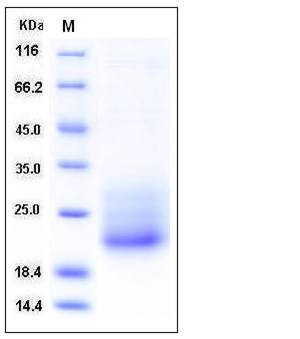Mouse CD7 Protein (His Tag)
RP23-400P17.1
- 100ug (NPP2686) Please inquiry
| Catalog Number | P50393-M08H |
|---|---|
| Organism Species | Mouse |
| Host | Human Cells |
| Synonyms | RP23-400P17.1 |
| Molecular Weight | The secreted recombinant mouse CD7 comprises 138 amino acids and has a predicted molecular mass of 15.7 kDa. As a result of glycosylation, the apparent molecular mass of rmCD7 is approximately 20-30 kDa in SDS-PAGE under reducing conditions. |
| predicted N | Gln 24 |
| SDS-PAGE |  |
| Purity | > 94 % as determined by SDS-PAGE |
| Protein Construction | A DNA sequence encoding the mouse CD7 (NP_033984.1) extracellular domain (Met 1-Pro 150) was fused with a polyhistidine tag at the C-terminus. |
| Bio-activity | Measured by its ability to bind biotinylated recombinant human SECTM1 in a functional ELISA. |
| Research Area | Immunology |Signal Transduction |Transcription Factors and Regulators |Immunoglobulin-Like Domain Transcription Factors |
| Formulation | Lyophilized from sterile PBS, pH 7.4 1. Normally 5 % - 8 % trehalose, mannitol and 0.01% Tween80 are added as protectants before lyophilization. Specific concentrations are included in the hardcopy of COA. |
| Background | The cluster of differentiation (CD) system is commonly used as cell markers in immunophynotyping. Different kinds of cells in the immune system can be identified through the surface CD molecules which associating with the immune function of the cell. There are more than 320 CD unique clusters and subclusters have been identified. Some of the CD molecules serve as receptors or ligands important to the cell through initiating a signal cascade which then alter the behavior of the cell. Some CD proteins do not take part in cell signal process but have other functions such as cell adhesion. CD7 is a transmembrane protein which is a member of the immunoglobulin superfamily. This protein is found on thymocytes and mature T cells. It plays an essential role in T-cell interactions and also in T-cell / B-cell interaction during early lymphoid development. |
| Reference |
